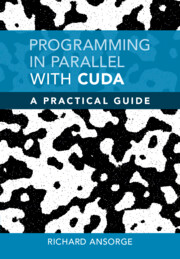Refine search
Actions for selected content:
849 results in Scientific Computing, Scientific Software
1 - Introduction to GPU Kernels and Hardware
-
- Book:
- Programming in Parallel with CUDA
- Published online:
- 04 May 2022
- Print publication:
- 02 June 2022, pp 1-21
-
- Chapter
- Export citation
7 - Concurrency Using CUDA Streams and Events
-
- Book:
- Programming in Parallel with CUDA
- Published online:
- 04 May 2022
- Print publication:
- 02 June 2022, pp 209-238
-
- Chapter
- Export citation
Appendix B - Atomic Operations
-
- Book:
- Programming in Parallel with CUDA
- Published online:
- 04 May 2022
- Print publication:
- 02 June 2022, pp 382-386
-
- Chapter
- Export citation
11 - Tensor Cores
-
- Book:
- Programming in Parallel with CUDA
- Published online:
- 04 May 2022
- Print publication:
- 02 June 2022, pp 358-372
-
- Chapter
- Export citation
6 - Monte Carlo Applications
-
- Book:
- Programming in Parallel with CUDA
- Published online:
- 04 May 2022
- Print publication:
- 02 June 2022, pp 178-208
-
- Chapter
- Export citation
4 - Parallel Stencils
-
- Book:
- Programming in Parallel with CUDA
- Published online:
- 04 May 2022
- Print publication:
- 02 June 2022, pp 106-141
-
- Chapter
- Export citation
Examples
-
- Book:
- Programming in Parallel with CUDA
- Published online:
- 04 May 2022
- Print publication:
- 02 June 2022, pp xv-xviii
-
- Chapter
- Export citation
Figures
-
- Book:
- Programming in Parallel with CUDA
- Published online:
- 04 May 2022
- Print publication:
- 02 June 2022, pp x-xii
-
- Chapter
- Export citation
Index
-
- Book:
- Programming in Parallel with CUDA
- Published online:
- 04 May 2022
- Print publication:
- 02 June 2022, pp 448-454
-
- Chapter
- Export citation

Programming in Parallel with CUDA
- A Practical Guide
-
- Published online:
- 04 May 2022
- Print publication:
- 02 June 2022
1 - Getting Started
-
- Book:
- The Student's Introduction to <I>Mathematica</I> and the Wolfram Language
- Published online:
- 01 April 2019
- Print publication:
- 16 May 2019, pp 1-26
-
- Chapter
- Export citation
4 - Algebra
-
- Book:
- The Student's Introduction to <I>Mathematica</I> and the Wolfram Language
- Published online:
- 01 April 2019
- Print publication:
- 16 May 2019, pp 145-190
-
- Chapter
- Export citation
9 - 3D Printing
-
- Book:
- The Student's Introduction to <I>Mathematica</I> and the Wolfram Language
- Published online:
- 01 April 2019
- Print publication:
- 16 May 2019, pp 457-522
-
- Chapter
- Export citation
3 - Functions and Their Graphs
-
- Book:
- The Student's Introduction to <I>Mathematica</I> and the Wolfram Language
- Published online:
- 01 April 2019
- Print publication:
- 16 May 2019, pp 51-144
-
- Chapter
- Export citation
Index
-
- Book:
- The Student's Introduction to <I>Mathematica</I> and the Wolfram Language
- Published online:
- 01 April 2019
- Print publication:
- 16 May 2019, pp 523-534
-
- Chapter
- Export citation
Frontmatter
-
- Book:
- The Student's Introduction to <I>Mathematica</I> and the Wolfram Language
- Published online:
- 01 April 2019
- Print publication:
- 16 May 2019, pp i-iv
-
- Chapter
- Export citation
2 - Working with Mathematica
-
- Book:
- The Student's Introduction to <I>Mathematica</I> and the Wolfram Language
- Published online:
- 01 April 2019
- Print publication:
- 16 May 2019, pp 27-50
-
- Chapter
- Export citation
Contents
-
- Book:
- The Student's Introduction to <I>Mathematica</I> and the Wolfram Language
- Published online:
- 01 April 2019
- Print publication:
- 16 May 2019, pp vii-x
-
- Chapter
- Export citation
5 - Calculus
-
- Book:
- The Student's Introduction to <I>Mathematica</I> and the Wolfram Language
- Published online:
- 01 April 2019
- Print publication:
- 16 May 2019, pp 191-248
-
- Chapter
- Export citation
Preface
-
- Book:
- The Student's Introduction to <I>Mathematica</I> and the Wolfram Language
- Published online:
- 01 April 2019
- Print publication:
- 16 May 2019, pp xi-xiv
-
- Chapter
- Export citation
